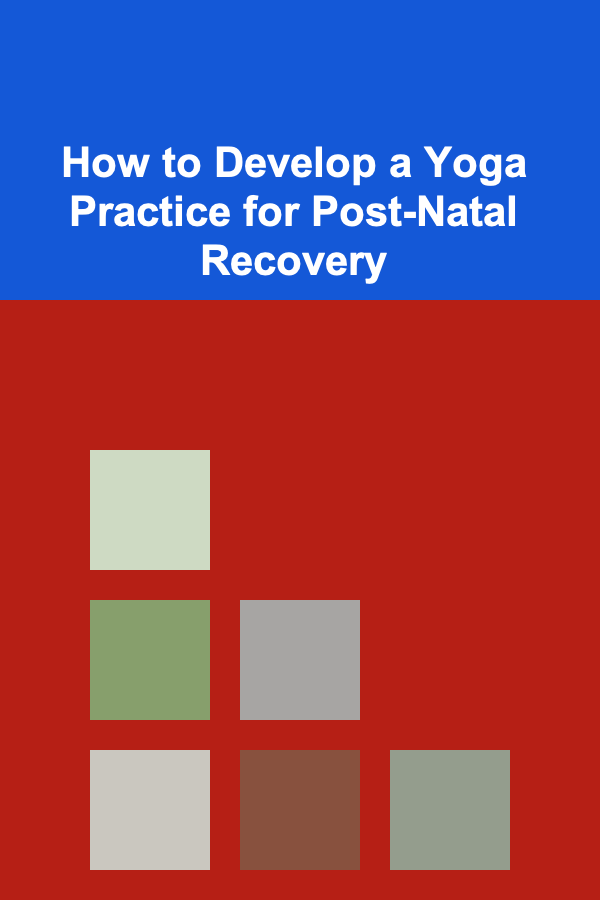
How to Develop a Yoga Practice for Post-Natal Recovery
ebook include PDF & Audio bundle (Micro Guide)
$12.99$8.99
Limited Time Offer! Order within the next:

The journey through childbirth and the post-natal period is a transformative experience for a mother, physically and emotionally. While childbirth is a natural event, the recovery process can be demanding, requiring careful attention to both physical and mental well-being. One of the most effective tools for post-natal recovery is yoga. With its blend of gentle movements, breath work, and mindfulness, yoga can aid in healing the body, reducing stress, and reconnecting with oneself after the significant life change that is motherhood.
In this article, we will explore how to develop a yoga practice for post-natal recovery, focusing on the physical and emotional aspects of healing, tips for creating a practice, and the essential principles to keep in mind for safety and effectiveness. Whether you're a new mother or an experienced yogi, yoga can offer immense support during this healing phase.
Understanding Post-Natal Recovery
The Physical Changes Post-Childbirth
After childbirth, the body goes through a variety of changes as it adjusts to the new physical reality of motherhood. The pelvic floor muscles, which supported the growing baby during pregnancy, may be weakened or overstretched. The abdomen, specifically the rectus abdominis (the "six-pack" muscles), may have separated due to the physical strain of carrying a baby. The hormonal changes that occur after childbirth can also affect the joints, leading to increased laxity and vulnerability to injury.
Additionally, a mother may experience fatigue, discomfort in the lower back, and tightness in the hips, neck, and shoulders due to the new demands of breastfeeding, carrying the baby, and adjusting to a new routine.
Yoga helps address these concerns by gently strengthening weakened muscles, improving flexibility, and creating a sense of balance in both the body and the mind. By incorporating breath work and mindfulness, yoga also provides emotional support, helping mothers navigate the often overwhelming transition into motherhood.
Emotional Aspects of Post-Natal Recovery
Post-natal recovery is not only about physical healing; emotional recovery is just as crucial. The postpartum period can bring about feelings of anxiety, sadness, or even postpartum depression. Yoga offers an opportunity to reconnect with one's body and mind, offering space for self-compassion and emotional release. Breath work and meditation can be particularly beneficial for calming the nervous system and reducing feelings of stress and overwhelm.
Why Yoga for Post-Natal Recovery?
Yoga offers numerous benefits for post-natal recovery, both physically and emotionally. Let's explore some key reasons why yoga is an ideal practice for new mothers:
1. Restores Core Strength
Yoga is an excellent way to restore core strength, which is often weakened after childbirth. Poses that engage the abdominal muscles help to close any abdominal separation (diastasis recti) and strengthen the pelvic floor. By working on deep core muscles, yoga can support the body's recovery process and improve posture, which may be compromised during pregnancy and breastfeeding.
2. Improves Flexibility
Many mothers find themselves with tight hips, shoulders, and lower back after pregnancy, particularly due to the postures required while holding and feeding the baby. Yoga poses, such as hip openers and gentle backbends, can help release tension, increase mobility, and reduce discomfort.
3. Enhances Emotional Well-being
Yoga encourages mindfulness, which helps new mothers focus on the present moment rather than getting overwhelmed by the constant changes happening around them. Through breath work and relaxation techniques, yoga promotes emotional healing, helping to balance the hormonal changes that can impact mood.
4. Increases Energy and Reduces Fatigue
The exhaustion that comes with caring for a newborn can be overwhelming. However, regular yoga practice can help boost energy levels. As yoga enhances circulation and promotes relaxation, it can improve sleep quality, reduce stress, and replenish energy levels, helping mothers feel more revitalized.
5. Supports Mental Clarity
Postpartum can bring a cloud of confusion and stress. Yoga offers an opportunity for self-care, which is essential for mental clarity. It can help mothers feel grounded and regain a sense of calm and focus amidst the demands of caring for their baby.
Starting Your Yoga Practice for Post-Natal Recovery
Timing: When to Start Yoga After Birth
It is important to note that the timing for beginning a yoga practice post-birth varies for each woman, depending on the type of delivery and individual health. In general, it is advised to wait at least six weeks after a vaginal birth and up to eight weeks after a cesarean section before beginning any physical activity. However, some gentle yoga practices, such as breathing exercises and restorative poses, can be practiced as soon as a woman feels ready, even before the six-week mark.
It is always best to consult with a healthcare provider or a certified post-natal yoga instructor before starting a yoga practice to ensure the exercises are safe for your specific recovery needs.
Creating Your Yoga Practice
When developing a yoga practice for post-natal recovery, it's important to start slow and be patient with your body. The goal is not to push yourself to achieve advanced postures, but rather to nurture the body back into balance. Here are some tips for creating a safe and effective post-natal yoga routine:
1. Focus on Breath Work
Breathing exercises are an excellent way to reconnect with the body and release any tension. The focus on deep belly breathing in yoga can help strengthen the diaphragm, pelvic floor, and abdominals. In post-natal recovery, breath work also calms the nervous system and reduces stress.
One simple breath technique to start with is diaphragmatic breathing, also known as "belly breathing." Sit comfortably or lie down with your hands on your belly. As you inhale, expand the belly, and as you exhale, gently draw the belly button towards the spine. This practice will help activate the deep core muscles and encourage relaxation.
2. Start with Gentle Poses
When beginning a post-natal yoga practice, start with gentle poses that focus on stretching and releasing tension, such as:
- Cat-Cow Pose (Marjaryasana-Bitilasana): This pose gently mobilizes the spine and helps improve flexibility in the back and neck.
- Child's Pose (Balasana): A restorative posture that helps release tension in the hips, lower back, and shoulders.
- Sphinx Pose (Salamba Bhujangasana): A gentle backbend that opens the chest and strengthens the lower back.
- Seated Forward Fold (Paschimottanasana): A gentle stretch for the hamstrings and lower back.
Focus on poses that support mobility in the hips, back, and shoulders, which can become tight from breastfeeding and holding the baby.
3. Incorporate Pelvic Floor Exercises
The pelvic floor is one of the most affected areas during and after childbirth. Incorporating pelvic floor exercises into your practice helps strengthen this vital area and improve bladder control, reduce discomfort, and support core strength. Some poses that engage the pelvic floor include:
- Bridge Pose (Setu Bandhasana): A great pose for strengthening the pelvic floor, glutes, and lower back.
- Squats (Malasana): A gentle way to engage the pelvic floor while opening the hips.
- Kegel Exercises: In between your yoga practice, remember to engage in pelvic floor contractions (Kegels), which help strengthen the muscles that support the bladder and reproductive organs.
4. Focus on Gentle Core Work
The abdominal muscles require time to heal after childbirth, especially in cases of diastasis recti (abdominal separation). Start with gentle, deep core engagement exercises, such as:
- Pelvic Tilts: Lying on your back with your knees bent, gently tilt your pelvis towards your ribs while engaging your core.
- Tabletop Leg Lifts: Lying on your back, gently lift one leg at a time while keeping your core engaged. This helps activate the lower abdominal muscles.
Avoid traditional crunches or sit-ups, as these can put unnecessary pressure on the abdominal muscles and exacerbate diastasis recti.
5. Allow Rest and Recovery
Yoga is not just about movement; it's also about rest and recovery. Incorporate restful poses, such as:
- Corpse Pose (Savasana): Allow yourself to relax and focus on your breath. Savasana helps integrate the benefits of the practice and calms the mind.
- Legs-Up-the-Wall Pose (Viparita Karani): A restorative posture that helps reduce swelling in the legs and allows for relaxation.
Remember, it's important to listen to your body and take breaks whenever needed. Post-natal recovery is a gradual process, and it's crucial to be kind and patient with yourself.
Practicing Mindfulness and Meditation
Yoga isn't just about physical poses; it's also about cultivating a sense of mindfulness. Post-natal yoga can help mothers reconnect with their bodies and their emotions through meditation and mindfulness practices.
Simple meditation techniques such as focusing on the breath, body scan practices, or loving-kindness meditation can help reduce anxiety, enhance emotional resilience, and promote a sense of peace during the often chaotic postpartum period.
Conclusion: A Balanced Approach to Post-Natal Recovery
Developing a yoga practice for post-natal recovery requires patience, self-awareness, and consistency. It's important to focus on gentle movements, core strengthening, pelvic floor rehabilitation, and mindfulness to aid in the healing process. Yoga can support new mothers as they recover physically, emotionally, and mentally, offering a sense of balance and well-being during a time of great transition.
Remember, there is no rush in the post-natal period. Listen to your body, be patient with yourself, and honor your unique journey as you restore strength and vitality.

How to Declutter and Clean Your Home Before a Move
Read More
How to Foster a Habit of Daily Tidying in Your Bedroom
Read More
How to Implement Live Chat to Increase Conversions in Your Dropshipping Store
Read More
How to Set Up a Profitable Catering Takeaway Business
Read More
The Power of Diversity: How to Stand Out by Embracing Differences
Read More
How to Make a Basic Vinaigrette: A Step-by-Step Guide
Read MoreOther Products

How to Declutter and Clean Your Home Before a Move
Read More
How to Foster a Habit of Daily Tidying in Your Bedroom
Read More
How to Implement Live Chat to Increase Conversions in Your Dropshipping Store
Read More
How to Set Up a Profitable Catering Takeaway Business
Read More
The Power of Diversity: How to Stand Out by Embracing Differences
Read More